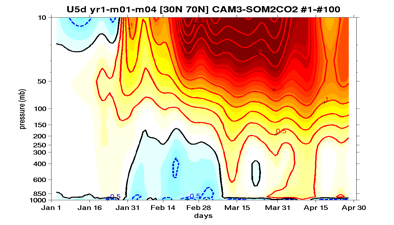|
The poleward shift of mid-latitude storm tracks in the 21st Century The mid-latitude storm tracks are fundamental features of the Earth's climate system. Arising from baroclinic instability, the transient eddies within the storm tracks move heat, moisture, momentum and energy poleward playing an essential role in the planet's energy balance. Much of mid-latitude precipitation occurs along the frontal systems of the eddies. This is in turn tightly coupled to the momentum transport by the eddies which drives mid-latitude ascent and subtropical descent enabling the wet conditions in mid-latitudes poleward of subtropical dry zones. It is an interesting - and important - aspect of global warming driven by rising greenhouse gases (GHGs) that the storm tracks shift poleward, the altitude of maximum eddy activity moves upward and, in many models, the storm tracks strengthen. These shifts, and the associated increase and poleward shift in poleward moisture transport by transient eddies, help contribute to the drying and expansion of the subtropical dry zones. It is therefore highly important to characterize this change and determine the causes for it. In a paper published in 2010 here Wu et al. examined in detail the nature of the shift, its relation to changes in the energy budget, and its possible causes within the Geophysical Fluid Dynamics Laboratory (GFDL) Climate Model 2.1 (CM2.1). They found that the intensification of the storm track as GHG concentration rose was an important component of an increase in poleward energy transport that accompanied increased radiative gain in the tropics and subtropics and increased radiative loss at higher latitudes. They also found that the increase in poleward transport of energy arose from a combination of 1) an increase in the poleward temperature gradient at the upper tropopause level, 2) an increase in the eddy activity, 3) an increase in the correlation between meridional velocity and moist static energy anomalies and 4) an increase in the length scale of eddies. Much of the dynamical changes could be accounted for by an increase in the strength of eddies at the lower frequency, large spatial scale part of the spectrum of baroclinic instability. Wu et al. were not able to explain the sequence of cause and effect that leads to these changes. This has been the topic of ongoing research using an interesting modeling strategy. A 100 member ensemble of simulations of an atmosphere GCM coupled to a mixed layer ocean is performed in which each ensemble member has CO2 instantaneously doubled and is then integrated forward for a few decades. A companion 100 member ensemble uses the same initial conditions but keeps CO2 constant. By averaging across the ensembles the day to day adjustment of the mean and transient circulation to a doubling of CO2 can be examined. This work points to the succession of events beginning with a direct radiatively-forced cooling of the stratosphere, followed by a change in stratospheric circulation and then a subsequent change in the troposphere (akin to 'downward control' anomalies seen in seasonal annular model anomalies). The changed transient tropospheric circulation then forces a change in the thermal structure of the troposphere that feeds back on the mean and transient state until a new equilibrium is created. The ongoing research is presented by Yutian Wu here and presented in two papers published in Journal of Climate. Wu et al, 2012 and Wu et al, 2013 REFERENCES
|
